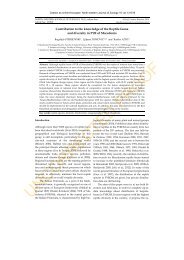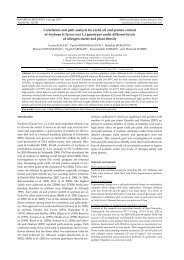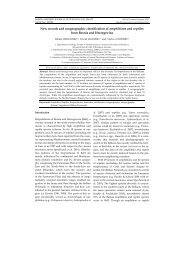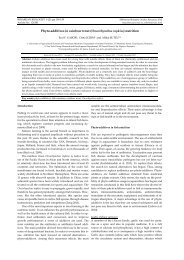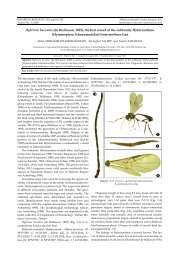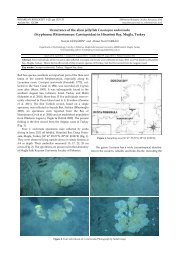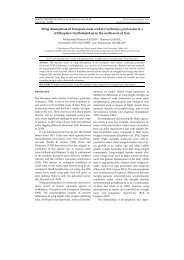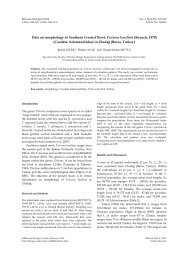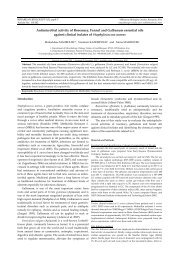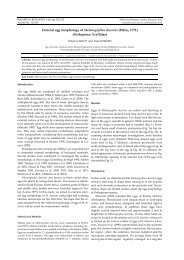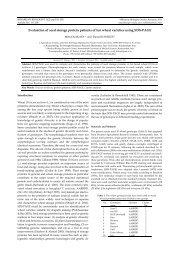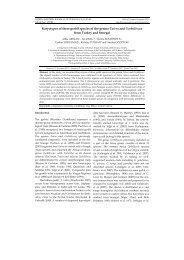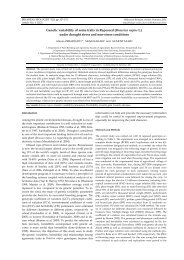Note on the food composition of a Pelophylax ridibundus (Amphibia ...
Note on the food composition of a Pelophylax ridibundus (Amphibia ...
Note on the food composition of a Pelophylax ridibundus (Amphibia ...
Create successful ePaper yourself
Turn your PDF publications into a flip-book with our unique Google optimized e-Paper software.
34<br />
Results<br />
Overall, <strong>the</strong> P. <strong>ridibundus</strong> populati<strong>on</strong> from Dubova c<strong>on</strong>sumed<br />
303 preys pertaining to 29 prey taxa (Tables 1 and 4),<br />
all 56 analyzed individuals presenting certain stomach c<strong>on</strong>tents.<br />
In additi<strong>on</strong> to <strong>the</strong> prey <strong>of</strong> animal origins, we found<br />
vegetal residue, shed skin remnants and various inorganic<br />
elements (Table 2). The majority <strong>of</strong> preys were terrestrial<br />
(96.69%) The average numbers <strong>of</strong> preys / individual was<br />
5.41, while <strong>the</strong> maximum number <strong>of</strong> prey / individual was<br />
16 (Table 3). The most important preys for this P. <strong>ridibundus</strong><br />
populati<strong>on</strong> were ants (Table 4). The ants were followed, according<br />
to percentage abundance, by <strong>the</strong> gastropods, and according<br />
to frequency by <strong>the</strong> gastropods and araneidae. The<br />
majority <strong>of</strong> <strong>the</strong> prey taxa identified in <strong>the</strong> stomach c<strong>on</strong>tents<br />
registered low value <strong>of</strong> percentage abundance and frequency<br />
<strong>of</strong> c<strong>on</strong>sumpti<strong>on</strong>.<br />
Table 1. The total number <strong>of</strong> prey items. The maximum and<br />
average number <strong>of</strong> prey items / individuals.<br />
Adults Juveniles Total<br />
No <strong>of</strong> prey items 175 128 303<br />
Maxim no. <strong>of</strong> preys<br />
/individual<br />
Average no. <strong>of</strong><br />
preys /individual<br />
16 12 16<br />
6.48 4.41 5.41<br />
Table 2. The frequency <strong>of</strong> occurrence <strong>of</strong> n<strong>on</strong>-animal<br />
stomach c<strong>on</strong>tents.<br />
Adults Juveniles Total<br />
% vegetal remains 74.07 48.28 60.71<br />
% shed skin 22.22 24.14 23.21<br />
% anorganic remains 14.81 13.79 14.29<br />
Table 3. The percentage abundance <strong>of</strong> aquatic and terrestrial preys.<br />
Adults Juveniles Total<br />
% terrestrial preys 95.42 98.43 96.69<br />
% aquatic preys 4.57 1.56 3.30<br />
There are several distincti<strong>on</strong>s between <strong>the</strong> diet <strong>of</strong> adults<br />
and juveniles, regarding <strong>the</strong> number <strong>of</strong> prey taxa, <strong>the</strong> number<br />
<strong>of</strong> c<strong>on</strong>sumed preys as well as <strong>the</strong> <strong>food</strong> diversity or vegetal<br />
c<strong>on</strong>sumpti<strong>on</strong>, etc.. Thus, in <strong>the</strong> case <strong>of</strong> juveniles <strong>the</strong> <strong>food</strong><br />
diversity was more reduced compared to <strong>the</strong> <strong>food</strong> <strong>of</strong> adults<br />
(juveniles H = 1.81 / adults H= 2.25) (Table 5). Likewise, <strong>the</strong><br />
adults c<strong>on</strong>sumed more prey taxa than <strong>the</strong> juveniles (24 compared<br />
to 20), and also more preys (6.48 preys / individual<br />
for adults up against <strong>on</strong>ly 4.41 preys / individual for juveniles).<br />
The differences between adults and juveniles can also<br />
be noticed in regards to <strong>the</strong> percentage abundance and frequency<br />
<strong>of</strong> c<strong>on</strong>sumpti<strong>on</strong> <strong>of</strong> <strong>the</strong> main tax<strong>on</strong>omic prey types<br />
(Table 4).<br />
Discussi<strong>on</strong>s<br />
The <strong>food</strong> <strong>of</strong> <strong>the</strong> P. <strong>ridibundus</strong> populati<strong>on</strong> from Dubova<br />
mainly c<strong>on</strong>sists <strong>of</strong> ants. Due to <strong>the</strong> predominance <strong>of</strong> this<br />
prey taxa, <strong>the</strong> diet <strong>of</strong> this populati<strong>on</strong> seems to be more simi-<br />
Cicort-Lucaciu, A.Ş. et al.<br />
lar to <strong>the</strong> <strong>food</strong> <strong>of</strong> Bombina variegata or Epidalea viridis, for<br />
whom ants are very important (e.g Groza et al. 2008, Kovacs<br />
et al. 2010, Ferenti et al. 2009, Covaciu-Marcov et al. 2010a,<br />
2011, 2012), than to <strong>the</strong> <strong>food</strong> <strong>of</strong> o<strong>the</strong>r c<strong>on</strong>specific populati<strong>on</strong>s<br />
(e.g. Cicek & Mermer 2006, Balint et al. 2010, Mollov 2008).<br />
However, as l<strong>on</strong>g as generally any trophic preferences have<br />
not been noticed in <strong>the</strong> case <strong>of</strong> P. <strong>ridibundus</strong> and <strong>the</strong> green<br />
frogs, dem<strong>on</strong>strating <strong>the</strong> existence <strong>of</strong> trophic opportunism<br />
(e.g. Cicek & Mermer 2006, Paunovic et al. 2010), <strong>the</strong> abundance<br />
<strong>of</strong> ants in <strong>the</strong> <strong>food</strong> <strong>of</strong> <strong>the</strong> P. <strong>ridibundus</strong> populati<strong>on</strong> from<br />
Dubova probably does not represent <strong>the</strong> result <strong>of</strong> <strong>the</strong>ir selectivity<br />
in relati<strong>on</strong> to ants, being <strong>on</strong>ly <strong>the</strong> result <strong>of</strong> ant abundance<br />
near <strong>the</strong> stream. Never<strong>the</strong>less, an increased percentage<br />
abundance and frequency <strong>of</strong> c<strong>on</strong>sumpti<strong>on</strong> <strong>of</strong> ants had<br />
been previously noticed in <strong>the</strong> <strong>food</strong> <strong>of</strong> a P. <strong>ridibundus</strong> populati<strong>on</strong><br />
from an artificial habitat, where <strong>the</strong> frogs c<strong>on</strong>sumed<br />
numerous terrestrial preys (Cicort-Lucaciu et al. 2011).<br />
The marsh frogs from Dubova were most likely forced to<br />
hunt in <strong>the</strong> terrestrial envir<strong>on</strong>ment due to <strong>the</strong> reduced size <strong>of</strong><br />
<strong>the</strong>ir habitat. This fact determined <strong>the</strong> categorical predominance<br />
<strong>of</strong> terrestrial preys in <strong>the</strong>ir <strong>food</strong>, because in specific<br />
circumstances <strong>the</strong> green frogs had c<strong>on</strong>sumed aquatic preys<br />
more frequently (Covaciu-Marcov et al. 2000, Mollov 2008,<br />
Sas et al. 2009). Thereby, <strong>the</strong> aquatic preys in Dubova represented<br />
<strong>on</strong>ly 3.30% <strong>of</strong> <strong>the</strong> total number <strong>of</strong> c<strong>on</strong>sumed preys<br />
(Table 3). The amount <strong>of</strong> aquatic preys is reduced regarding<br />
both <strong>the</strong> number <strong>of</strong> prey taxa, as well as <strong>the</strong> number <strong>of</strong> preys<br />
from those taxa. A large part <strong>of</strong> <strong>the</strong> small amount <strong>of</strong> aquatic<br />
preys was represented by larvae or adults <strong>of</strong> <strong>the</strong> own species,<br />
as well as in o<strong>the</strong>r cases (e.g. Cogălniceanu et al. 2000a,<br />
Mollov 2008).<br />
Unlike <strong>the</strong> adults, <strong>the</strong> P. <strong>ridibundus</strong> juveniles display a<br />
less various and intense feeding. Thus, <strong>the</strong>y c<strong>on</strong>sumed a<br />
slightly reduced number <strong>of</strong> preys, from a slightly reduced<br />
number <strong>of</strong> prey taxa. The absence <strong>of</strong> certain prey taxa from<br />
<strong>the</strong> <strong>food</strong> <strong>of</strong> juveniles had been presumably determined by<br />
<strong>the</strong> great size <strong>of</strong> that preys that could not be swallowed by<br />
<strong>the</strong> juveniles. Hereby, <strong>the</strong> Diplopoda or <strong>the</strong> Orthoptera<br />
sometimes have <strong>the</strong> sizes <strong>of</strong> <strong>the</strong> P. <strong>ridibundus</strong> juveniles. The<br />
larvae and especially o<strong>the</strong>r specimens <strong>of</strong> P. <strong>ridibundus</strong> are not<br />
included in <strong>the</strong> diet <strong>of</strong> <strong>the</strong> juveniles, due to <strong>the</strong> same reas<strong>on</strong>s.<br />
The differences between <strong>the</strong> diet <strong>of</strong> <strong>the</strong> adults and <strong>the</strong> diet <strong>of</strong><br />
<strong>the</strong> juveniles have been explained in <strong>the</strong> case <strong>of</strong> o<strong>the</strong>r amphibian<br />
species as well through <strong>the</strong>ir different sizes (eg: Cogălniceanu<br />
et al. 2000a, Ferenti & Covaciu-Marcov 2011, Polymeni<br />
et al. 2011). Meanwhile, <strong>the</strong> size differences determined<br />
<strong>the</strong> existence <strong>of</strong> important distincti<strong>on</strong>s in <strong>the</strong> <strong>food</strong><br />
compositi<strong>on</strong> or certain species <strong>of</strong> amphibians in <strong>the</strong> same<br />
habitat (eg: Cogălniceanu et al. 2000a, Arroyo et al. 2008, Covaciu-Marcov<br />
et al. 2012b).<br />
Yet, <strong>the</strong> absence <strong>of</strong> some prey taxa from <strong>the</strong> stomachs <strong>of</strong><br />
<strong>the</strong> juveniles cannot be explained through <strong>the</strong>ir sizes in all <strong>of</strong><br />
<strong>the</strong> circumstances. Thus, for example, <strong>the</strong> snout beetles reach<br />
sizes that can allow <strong>the</strong>ir c<strong>on</strong>sumpti<strong>on</strong> by P. <strong>ridibundus</strong> juveniles;<br />
however this kind <strong>of</strong> prey is not present in <strong>the</strong> diet <strong>of</strong><br />
juveniles. It is also possible that <strong>the</strong> adults can travel <strong>on</strong> larger<br />
distance than <strong>the</strong> juveniles, dislodging to a greater distance<br />
from <strong>the</strong>ir aquatic habitat. Therefore, <strong>the</strong> increased<br />
mobility <strong>of</strong> <strong>the</strong> adults could explain <strong>the</strong>ir exclusive Orthoptera<br />
c<strong>on</strong>sumpti<strong>on</strong> as well. In regards to o<strong>the</strong>r species <strong>of</strong> amphibians,<br />
Orthopteras have been c<strong>on</strong>sumed more <strong>of</strong>ten by



